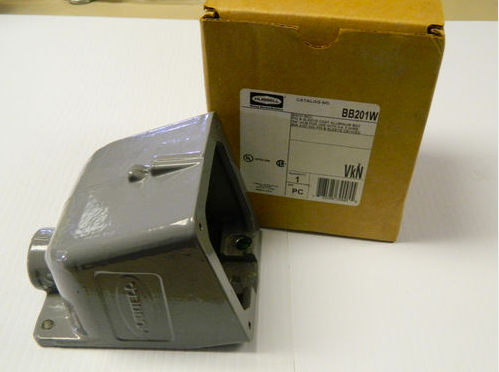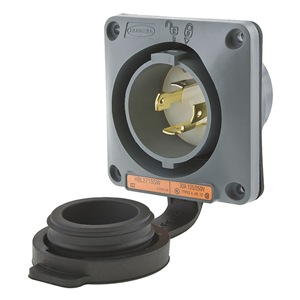Chefwong
Member
How exactly are these boxes generally mounted ?
I've yet to order the box....but wanted some info.

I've yet to order the box....but wanted some info.


How exactly are these boxes generally mounted ?

Not sure what you are asking here, but like any other box sounds like a good answer.
What do you think would be wrong with the mounting nole being on the inside. We mount many enclosures with screws on the inside such as but not limited to meter base, panel. four square boxes, ect.......I see top mounting holes and holes on the inside on the bottom. Surely, I don't think one is to mount the screw from inside the box to a wall ?
Well then your concern should be the use of the generator not the use of the box.Yes, it's for a portable generator.
I hear thunder, but there is no rain in sight.Who ever said this is going to be tied to the panel ?
This will be feeding a transfer switch.
Who ever said this is going to be tied to the panel ?
This will be feeding a transfer switch.
None of us here really want to argue code with you nor profess to know it as well as you do, and absolutely none of us want to be the cause of a lineman getting electrocuted. I'm sure every one of us to the very hardest nose of us would hate ourselves for the rest of our life if we caused the death of a lineman. If a store sells portable generators and also sells transfer panels supposedly to be used with them, they are doing a dis-service to everybody. Your example of a store selling the listed 30 amp breaker and 14 gauge wire is different. Lumber yards sell lumber and nails. Got to use the correct size nails and fasteners to do the job. The exact job determines the lumber and fasteners needed. If you go to HD and buy generator and they sell you at the same time a power transfer panel that is not safe to use per code, then they should be stopped from selling these items and be responsible for damages.If you are having a problem reading post #11 then you should not be messing with a portable generator and the wiring of a home.
Separately Derived System. A premises wiring system whose power is derived from a source of electric energy or equipment other than a service. Such systems have no direct connection from circuit conductors of one system to circuit conductors of another system, other than connections through the earth, metal enclosures, metallic raceways, or equipment grounding conductors
In a SDS the neutral is switched along with the hot conductors. In the link to the UL White Book portable generators are to be connected to the wiring system of a building as a SDS or the transfer MUST also switch the neutral.
Those small six to twelve circuit panels from Reliance do not switch the neutral therefore are not legal for the installation with portable generators.
When the cord from the generator lands at the building Article 225 says that the conductors MUST land in a disconnect that is suitable as service equipment. The cord and plug is not service rated nor are the small panels from the generator companies.
I have a GE 30 amp breaker that has a UL listing. I have a roll of #14 NM-B cable that has a UL listing. Can you tell me why I can’t install a circuit using the 30 amp breaker and the #14 conductors? The same rules apply to portable generators. Just because something has a UL listing in no way means that it can be installed in any other manner than what the codes and the listing of the equipment allows. Read the link in post #11.
You lost me at Hello JW....
Sorry, but in laymans terms....what exactly is wrong with the common transfer panels from Reliance, Generac, etc - that I presume we are discussing about ?
Here in lies a lot of liability for a homeowner or an electrical contractor. Safety must always come first in everything we do or we could end up in court trying to explain ourselfNone of us here really want to argue code with you nor profess to know it as well as you do, and absolutely none of us want to be the cause of a lineman getting electrocuted.
Not to mention any legal cost or penalties.I'm sure every one of us to the very hardest nose of us would hate ourselves for the rest of our life if we caused the death of a lineman.
Same store sells 2X4s and 4 penny finish nails. Is this a dis-service?If a store sells portable generators and also sells transfer panels supposedly to be used with them, they are doing a dis-service to everybody.
How is it different? Are you saying that your knowledge tells you this would be wrong but if you do not have the knowledge about something then it is different?Your example of a store selling the listed 30 amp breaker and 14 gauge wire is different.
This is exactly what I said but I used electrical equipment instead of lumber and nails.Lumber yards sell lumber and nails. Got to use the correct size nails and fasteners to do the job. The exact job determines the lumber and fasteners needed.
So you are saying that they should be punished for your lack of knowledge? Should they be stopped from selling 2X10s and finish nails to the same customer?If you go to HD and buy generator and they sell you at the same time a power transfer panel that is not safe to use per code, then they should be stopped from selling these items and be responsible for damages.
What I am saying is the codes allow for a proper installation and just because something works in no way means that it is proper. Without knowledge of what one is undertaking it will never be correct.So you are saying that a licensed electrician doing residential work would not install a transfer panel as Chef and you described, on a home for a portable generator. I'm not asking what a homeowner would do, because many homeowners should not be allowed to change a lightbulb, let alone install a system like this.
OSHA in 1910.333 and NFPA 70E mandate that if one is checking voltages or doing any other electrical testing that they wear the proper PPE. I have fired many who worked for me for not complying with the rules.Several years ago I was sent to one of our customers in Michigan to troubleshoot a problem on their multimillion dollar machine system built by my company. When I got there, the first thing they did was turn off the main panel that fed power to my machine because I removed the cover from our control panel so I could access the relay logic and inverter drives. They told me that MIOSHA fined them recently for running a machine with a panel open. I told them that they deserved that fine, but I also told them that in order for me to troubleshoot their problem, I needed the power on. They allowed me to proceed when I started packing up my tools to leave. Sometimes, just sometimes the rules are a bit TOO much, but they are necessary.
Any electrical system weather temporary or permanent is required to be connect by the use of a transfer switch that prevents the energizing of both systems at once.What Bob says is true, and I agree. The problem that I see with the switch over panels, is that they are Normally for permanent Installs and Not Temporary. Do you have a web link for the one you will be using ?
This is correct and should be used with cords that plugs each appliance in one at a timeThe Gen you plan to use is made for Temporary use, that is why it has a Twist Lock and is not direct wired.
Or Run Extension cords for what you want to power is the safest and cheapest way to use one of these type generators.Make sure you have a Disconnect that disconnects all conductors from the main Line feed, It needs to do that. Or Run Extension cords for what you want to power.
It in no way depends on my approval but it does need the approval of any adopted codes.What is safer ? Depends, on JW's Approval. Be careful playing with electricity.
I saw her at the Met last. Viking hat and all.
This is the time for the Fat Lady to sing; So WHERE are you?
Last time I seen her she was at the Nascar Race eating popcorn.
This is awkward, but...
It looks like you're using an ad blocker. We get it, but (1) terrylove.com can't live without ads, and (2) ad blockers can cause issues with videos and comments. If you'd like to support the site, please allow ads.
If any particular ad is your REASON for blocking ads, please let us know. We might be able to do something about it. Thanks.